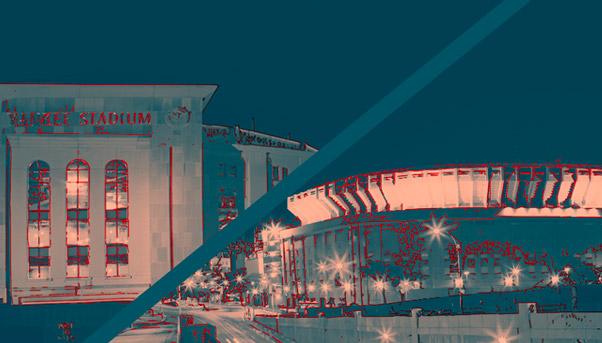
If there is one piece of infrastructure that can be associated with a sports hero, it is most definitely the Yankee Stadium with Babe Ruth. On April 18, 1923, the day New York’s famous stadium was inaugurated, the baseball champion hit his first home run out of the park. On that day, Ruth led the New York Yankees in their victory against the Boston Red Sox, and later that year their winning of the World Series, the U.S. baseball championship. Ever since then, , the stadium became a symbol not just of the Bronx – the working-class borough in the northern part of the city – but of New York City itself.
The idea of building a stadium in the Bronx was the brainchild of the owners of the Yankees, Tillinghast L’Hommedieu Huston and Jacob Ruppert. They were convinced that even though New York already had two excellent baseball teams, the New York Giants and the Brooklyn Dodgers, it still had space for the Yankees. So they decided to invest $2.5 million to build a 60,000-seat stadium. Construction began on May 5, 1922 and, 11 months later, it opened to the public.
The “Cathedral of Baseball” was more than just the home of the New York Yankees. It also hosted some of the world’s most spectacular boxing matches, from Muhammad Alì to Max Baer, from Sugar Ray Robinson to Joe Louis. Three popes celebrated mass there: Paul VI, John Paul II, and Benedict XVI. And some of its concerts were legendary. Match after match, game after game, concert after concert, the stadium endeared itself to New Yorkers and tourists alike until September 21, 2008, when, after hosting 6,581 official games of the New York Yankees, it went into “retirement”. Its gates closed, the stadium was demolished.
But it was not closed for long. Just a few metres away from the vanished symbol of New York, a new, modern, high-tech “cathedral” arose.

The new stadium
The Yankees began building their new home in 2006 in order to make sure that it would be ready to host the team’s fans by 2009. The old stadium had been renovated in the 1960s and 1970s, but by the start of the new century the facility had become outdated and no longer reflected the ambitions of a team like the Yankees nor a city like New York. The construction of the new stadium was a gargantuan effort, costing $1.6 billion. The sum was almost entirely financed by the New York Yankees, while the city of New York contributed about $300 million to cover the cost of building the infrastructure links and modernising the surrounding area. For example, the subway line that crosses the Bronx got a new stop at the stadium.
The new facility covers an area of 1.3 million square feet, is spread out over four floors, and can hold 52,000 spectators. The numbers tell the story. According to
stadium builder Turner Construction’s website, it required 7,000 steel structural blocks, 15,000 gallons of paint; 946 miles of electrical wiring; and 20,000 light bulbs.
The stadium’s appearance was designed to resemble its illustrious predecessor in terms of both materials and shape, creating a continuity with what had been the home of the Yankees for 80 years. Despite its similar appearance, the new facility is the epitome of modernity, both in terms of architecture and engineering. The LED screens mounted above the field are the largest ever seen in a baseball stadium. The stadium has set aside plenty of space for the team, for meetings, and for various types of entertainment, as well as special areas reserved for children. This work of infrastructure is so innovative that it won the “Project of the Year” from McGraw Hill Publications in 2009.
An auction for memorabilia
The transition from the old stadium to the new one was an historic moment for New Yorkers and baseball fans alike, as demonstrated by a remarkable event. To cover the $11.5 million bill to demolish the old stadium, the Yankees commissioned the Steiner Sports auction house to raise money by selling memorabilia from the building. The auction began in May 2009. For $1,499 it was possible to purchase a seat; for $150 a brick from Monumentum Park (where the Yankees celebrate their retiring members); turnstiles were priced at $2,000 and $200 could get you a garbage can with the NY insignia on it. It only took a few days for prices to be batted “out of the park”. That is how many people wanted to bring home a piece of Yankees history.


